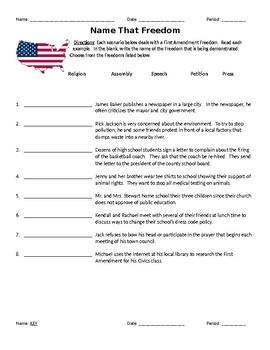
As a group talk through the First Amendment asking students to define each freedom in their own words. There are numerous pictures in the handouts to help illustrate these concepts.
ROLE PLAY Divide students into five groups and assign each group one of the freedoms protected by the First Amendment.
First amendment lesson plan. First Amendment Lesson Plans Here is a selection of lesson plans that cover various topics related to the First Amendment. Our lesson plans range from elementary to high school and were created by educators for educators. ROLE PLAY Divide students into five groups and assign each group one of the freedoms protected by the First Amendment.
Each group should create a scenario that would test the limits of its assigned freedom and present it to the class. Students should then decide whether the scenario represents a violation of First Amendment rights. They should use evidence from the article to support their points.
Divide students into five groups and assign each group one of the freedoms protected by the First Amendment. Each group should create a scenario that would test the limits of its assigned freedom and present it to the class. Students should then decide whether the scenario represents a violation of First Amendment rights.
Instructions Distribute the First Amendment Basics handout and give students a few moments to read it. As a group talk through the First Amendment asking students to define each freedom in their own words. Distribute the worksheet and have students brainstorm ways in which they usehave used and.
Read the First Amendment to the Constitution aloud to the class and help students understand what it is saying about freedom of speech. Congress shall make no law respecting an establishment of religion or prohibiting the free exercise thereof. Or abridging the freedom of speech or of the press.
Or the right of the people peaceably to assemble and to petition the Government for a redress of grievances. Under the establishment clause of the First Amendment and in line with US. Supreme Court rulings public schools may not impose prayer or other religious practices on students even if students are not required to participate.
The first religion clause says government and its agencies are prohibited from establishing or requiring religion including official attempts to impose or instill beliefs in students. This prohibition prevents government from setting up a national religion. This site from the National Endowment for the Humanities offers a lesson plan titled The First Amendment.
Whats Fair in a Free Country Its geared toward grades K-5. Balancing rights and responsibilities is difficult even for the Supreme Court. This lesson demonstrates to students that freedom of speech is an ongoing process NEH says of this lesson plan which delves into such.
This lesson provides an opportunity for students to learn what the First Amendment is and why it is important to them today. Students will compare and contrast the rights provided in the First Amendment with freedoms found or not found in other countries around the world. Objectives Students will be introduced to the First Amendment text and components.
Speech This lesson encourages students to examine their own assumptions and to deepen their understanding of current accepted interpretations of speech rights under the First Amendment. This lesson covers details about the First Amendment and voting rights. There are numerous pictures in the handouts to help illustrate these concepts.
We have also included several 8 ½ x 11 visuals to use for class discussion. There are two activities a word search and sentence correction to help reinforce the new vocabulary and concepts. SPEECH LESSON PLAN 3 1 unable to limit the speech 2 rarely able to limit the speech 3 students are truly unsure 4 usually able to limit the speech 5 always able to limit the speech Students should mark an X in the appropriate column.
Each student will total her or his score at the bottom of the page. See worksheet on page 6. Students will learn what our rights are where they come from and how far they extend.
This lesson uses City of Ladue v. Gilleo as the basis for discussion of First Amendment rights. Students will argue for both sides of the case and a group of students will serve as the city council.
They will questions both sides and ultimately decide whether the ordinance should be upheld or not. This lesson plan encourages students to examine their assumptions about freedom of speech as well as to deepen their understanding of speech rights under the First Amendment. This lesson will focus on the 1st Amendment and even more specifically the section of the 1st Amendment that deals with Free Speech.
This lesson will be the second lesson about the Bill of Rights following a lesson on the overview and history of the Bill of Rights. Students use the newspaper as a tool to make connections about what the five freedoms guarantee in the First Amendment. In this first amendment lesson plan students analyze events in the newspaper to form conclusions about the freedoms.
This lesson plan is designed to introduce refugees to some fundamental rights in the United States which many Americans may take for granted. It is designed to instill confidence in their safety and build a sense of civic pride and responsibility. Outline of the Unit Plan.
This unit is designed to focus on the fifth grade standards in Social Science and Visual Art. Student learning analysis and understanding of historical documents The Constitution and Bill of Rights. Students begin to understand the significance of events and historical figures as seen through case law studies in shaping what we have as a government today.
Students will also learn.
